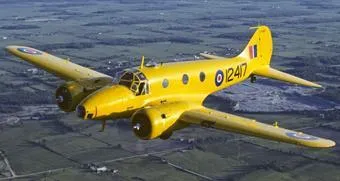Avro Anson

Canadian Warplane Heritage Museum
The Museum's Anson Mk. V was built by MacDonald Brothers in Winnipeg in 1944. It flew with No. 7 Photographic Wing and No. 414 Squadron in Ottawa on photo survey work until the late 1940s. In 1956, it was purchased by INCO and used for mineral surveying until 1980, when it was donated to the Museum. The exterior is painted in the yellow colour common to all BCATP trainers and is in its same wartime RCAF markings.
The Avro Anson was known by a number of nicknames including "Faithful Annie" or "Flying Greenhouse". It was the first aircraft to be flown by the Royal Canadian Air Force to have a retractable undercarriage, which was a comparative novelty in 1936. In 1940, a Canadian government owned company, Federal Aircraft Limited, was created in Montreal to manufacture the Anson for Canadian use. Nearly 3,000 Anson aircraft were produced and, in the early days of the British Commonwealth Air Training Plan (BCATP), the Anson was the standard trainer for many pilots, observers (navigators), wireless operators and bomb aimers. More than 20,000 aircrew received training on the Anson. In Canadian service, the aircraft was substantially re-designed with the substitution of North American engines and many other airframe and equipment changes. Harold Skaarup web pages
CASPIR Aircraft Groups:
RCAF On Strength (4404), RCAF 400 Squadron (6), Canadian Aircraft Losses (257)Anson Mk. II 7573
Delivered to stored reserve. Scheduled for tests of co-pilot brake controls at No. 6 Repair Depot from 15 May 1942, but this appears to have been cancelled. Issued from storage on 10 July 1942. Probably with No. 9 Service Flying Training School at Centralia, Ontario when it crashed and burned on 30 September 1942, 1 3/4 miles south of Centralia. Also reported with No. 5 SFTS at Brantford at time of crash. Request to scrap from No. 6 Repair Depot dated 22 October 1942, approved 5 November 1942.
1942-03-16 Taken on Strength No. 1 Training Command 2019-08-20
1942-September-30 Accident: 9 Service Flying Training School Loc: Aerodrome Names: Birky
1942-11-12 Struck off Strength Struck off, reduced to spares and produce 2019-08-20





 Canadian Virtual War Memorial
Canadian Virtual War Memorial Commonwealth War Graves Commission
Commonwealth War Graves Commission Library and Archives Canada Service Files (may not exist)
Library and Archives Canada Service Files (may not exist) Valparaiso, Illinois, USA
Valparaiso, Illinois, USA Harold A Skaarup Web Page
Harold A Skaarup Web Page Avro Anson History
Avro Anson History
 RCAF.Info - RCAF Station Summerside PEI
RCAF.Info - RCAF Station Summerside PEI